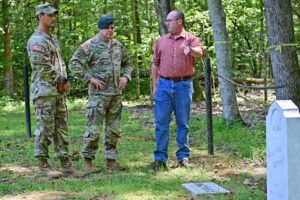A special marker is now in place at Fort Campbell—on the gravesite of more than 50 Native American remains, thanks to a collaboration between Fort Campbell and the Eastern Band of Cherokee Indians Tribal Historic Preservation Office.
Previous curators of the Fort Campbell Pratt Museum discovered 57 individuals and 516 associated funerary objects between 1930 and 2001 and efforts have been underway since to determine of the remains could be a identified and interred in the proper place. All the remains, as well as AFOs, were stored at the University of Kentucky until 2017, when they were transferred to the Cultural Resource Office at Fort Campbell. Four of these remains were relocated to the Land Between the Lakes National Recreation Area with coordination through the United States Forest Service.
Fort Campbell, in consultation with 12 Federally Recognized Native American Tribes, determined that there was not enough evidence to support cultural affiliation with any Tribe. It was requested the remains by buried as close as possible to the location they were discovered.
A cemetery created by the Army in the 1940s that housed German Prisoners of War who died in WWII was selected for the reburial site. A marker was placed showing their location that states, in both Cherokee and English “People from Kituwah. Kituwah, an ancient Native American settlement, is the original mother town of the Cherokee People.
Native Americans, including members of the Cherokee Nation, have proudly served in the U.S. military across military installations worldwide, leaving an undeniable impact on the armed forces. This includes Fort Campbell to this day, where Fort Campbell Garrison Commander and member of the Cherokee Nation Colonel Andrew Jordan serves.


